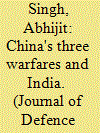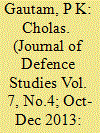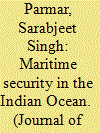| Srl | Item |
| 1 |
ID:
126124


|
|
|
|
|
| Publication |
2013.
|
| Summary/Abstract |
For the past decade, China is known to have actively used 'three warfares' (3Ws) strategy-media, psychological and legal warfare-to weaken its adversaries in regions constituting what it perceives to be its 'core interests'. While a wide range of tools have been deployed, the attacks have remained mostly confined to Taiwan and South-East Asian states involved in the territorial disputes in the South China Sea. But with Beijing's influence in South Asia and the Indian Ocean Region (IOR) growing, there is evidence emerging of the 3Ws strategy being put to use against India. The evolving Chinese 3Ws strategy goes beyond mere propaganda wars and misinformation campaigns. Expanding conventional war dynamics into the political domain, the 3Ws appear aimed at undermining India's organizational foundations and target military morale. More disquietingly, the strategy appears designed to subdue India without even needing to fight.
|
|
|
|
|
|
|
|
|
|
|
|
|
|
|
|
| 2 |
ID:
126126


|
|
|
|
|
| Publication |
2013.
|
| Summary/Abstract |
The article addresses the deficit in the indigenous, rich historical knowledge of south India. It does this by examining the military and political activities of the Cholas to understand the employment of various supplementary strategies. The article deals with the engagements and battles of the Cholas with other kingdoms of south India, and 'externally' with Sri Lanka. It begins with an exposition of various types of alliances that were an integral part of the military strategy of the time. It also seeks to historically contextualize modern diplomatic developments and explains some issues of indigenous historical knowledge of that period that are of relevance even in the twenty-first century: continued phenomenon of changing alliance system in politics; idea of India as a civilization; composition of the army; and the falsehood of the uncontested theory of the Indian defeat syndrome.
|
|
|
|
|
|
|
|
|
|
|
|
|
|
|
|
| 3 |
ID:
126121


|
|
|
|
|
| Publication |
2013.
|
| Summary/Abstract |
The Indian Ocean Region (IOR), though considered an important maritime region, has not yet been accorded the due importance of a geo-strategic entity. One attributable reason is the 'sandwiching' of the IOR between two 'hotspots'-the South China sea and the Persian Gulf that divert the attention of nations from this area. While there are commonalities like 'Freedom of Navigation', the divergences-caused by varying strategic interests even while addressing common security issues such as piracy-have resulted in a sectoral view of the maritime security paradigm in the IOR. The security picture is thus affected by the waning interest and presence of nations historically linked with the region as well as the advent of China. This article examines how the strategic interest of nations is affecting the maritime security conundrum of the IOR.
|
|
|
|
|
|
|
|
|
|
|
|
|
|
|
|
| 4 |
ID:
126127


|
|
|
|
|
| Publication |
2013.
|
| Summary/Abstract |
The future of an organization is less determined by outside forces than by its history and the Defence Research and Development Organization (DRDO) is no exception. This article analyses the major achievements and shortfalls of the DRDO. It models the strategic dimensions of organization development. The value of production from defence industries arising from DRDO technology transfers is rapidly escalating, enabling the government's goal of self-reliance. The historical 'licence production' culture in the aeronautics, electronics and guided missile industries sustains imports of raw materials and small components worth billions of dollars annually. The article suggests architectural changes to aid the conversion of this vulnerability into an opportunity to create indigenous techno-industrial infrastructure and market worth nearly
Rs 12,000 crore per annum through public-private partnerships. The way ahead is charted for techno-economic growth of self-reliant defence industry in partnership with the private sector by creating a Defence Techno-Industrial Consortium. Sustaining India's leadership in
|
|
|
|
|
|
|
|
|
|
|
|
|
|
|
|